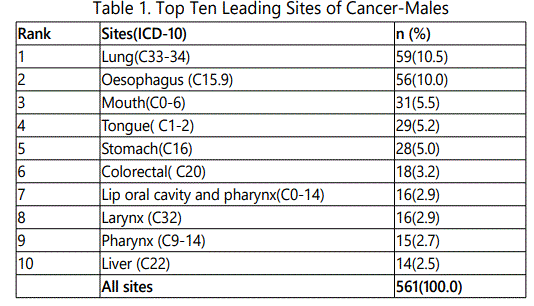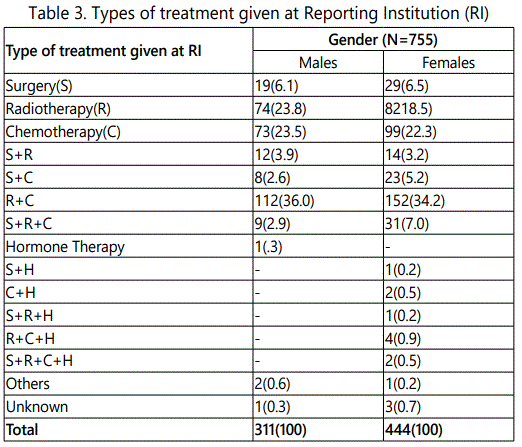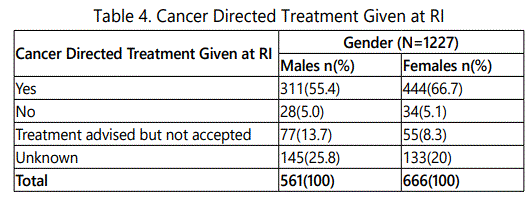Research Article
Patterns of Cancer at a Tertiary Care Hospital in Karnataka-India
1Department of Public Health, Manipal University, Manipal, Karnataka, India
2Department of Bio Statistics, Manipal University, Maniapl, Karnataka, India
*Corresponding author: Dharmappa Basavarajappa, Department of Public Health, Manipal University, Manipal, Karnataka, India, E-mail: dharesh13@gmail.com
Received: August 28, 2018 Accepted: September 17, 2018 Published: September 21, 2018
Citation: Basavarajappa D, Kamath R, Shetty B, Mayya S. Patterns of Cancer at a Tertiary Care Hospital in Karnataka-India Madridge J Cancer Stud Res. 2018; 2(1): 70-72. doi: 10.18689/mjcsr-1000110
Copyright: © 2018 The Author(s). This work is licensed under a Creative Commons Attribution 4.0 International License, which permits unrestricted use, distribution, and reproduction in any medium, provided the original work is properly cited.
Abstract
Background: Cancer is one of the non-communicable diseases that become an important contributor to the global burden of diseases. Cancer is a leading cause of death worldwide, around 13% of all deaths in 2008. About 70% of all cancer deaths occurred in low- and middle-income countries.
Aim: Patterns of cancer among patients attending a tertiary care cancer hospital in Karnataka, India.
Materials and Methods: The present retrospective study was carried out at tertiary care hospital in Udupi taluk-Karnataka, India. A total of 3,103 cancer patients were registered at the centre during the year 1st January 2011 to 31st December 2012, and of them 1227 cancer records were reviewed in the study. Data was collected by using the National Cancer Registry Program core form
Results: The sex distribution male to female was 0.84:1. Majority of male (43.1%) and female (41.7%) cancer patients were from Udupi district in Karnataka. The diagnosis of cancer was confirmed by microscopic method, among men 88.2% and among women 92% cancer diagnosis was done microscopic method. In women breast was the leading site of cancer (29.6%) followed by cervix uteri (20.4%) Among men lung is the leading site of cancer (10.5%).
Conclusion: The lung was a leading site of cancer among men and breast was the second leading site of the cancer among the women. Among men 88.2% and among women 92% diagnosis was done microscopically. Among men 36% had received the radiotherapy and chemotherapy (R+C) and among the women 34.2% had received radiotherapy and chemotherapy (R+C). Incidence of cancer cases increasing.
Keywords: Cancer, breast cancer, lung cancer, hospital based cancer study.
Introduction
Cancers, as they are defined, are a "Group of heterogeneous disorders characterized by clonality, autonomy, anaplasia and metastasis [1]. Various cancers, despite their diversity in clinic pathological manifestations, have some risk factors in common, a phenomenon that again binds them together and can be fruitfully utilized for the purpose of prevention. These common risk factors are primarily a reflection of unhealthy lifestyle and hence, the contemporary saying is that cancers are, by and large, diseases of unhealthy lifestyle and are; therefore, potentially preventable [2]. Worldwide approximately 10 million new cases and more than 6 million deaths (12% of all deaths) occur due to cancers every year. It is estimated that more than 22 million people would be living with cancers, worldwide at any given point of time [3]. The commonest cancers sites in men including lung, stomach, oral cavity and oesophagus, among women, cervix uteri, breast, oral cavity, ovary, oesophagus and Stomach are lead [4]. Cancer is currently the cause of 12% of all deaths worldwide [5]. There would be about 1.5 lakhs cancer cases at any given time in Karnataka and about 35,000 new cancer cases are added to this pool each year [6-7]. The primary purpose of study is to contribute to patient care by providing readily accessible information on the patients with cancer, the treatment received and its results. The data is also used for clinical research and for epidemiological purposes.
Objectives
To study the patterns of cancer at a tertiary care centre and to identify the different method of diagnosis and treatment modalities instituted at tertiary care.
Materials and Methods
Study Setting
The present retrospective study was carried out at tertiary care hospital Karnataka in Southern India. The study was conducted between February 2013 and July 2013. A total of 3103 cases were registered at 1st January 2011 to 31st December 2012, of whom 1227 cases were included in study. New cancer cases diagnosed by all methods or treated during this were identified from the registers maintained by the Medical Records Department of a tertiary care hospital. A total 1221 cancer case record has been evaluated. National Cancer Registry Program (NCRP) and Hospital Based Cancer Registry (HBCR) core forms was used to collect the data, which included identifying information, basic demography parameters, diagnosis details and details of stage and treatment.
Data Collection Method
The ethical permission was taken from the institute of ethical committee (IEC-251/2013) from tertiary care hospital. The information about the new registered cases at tertiary care hospital was listed from the registry maintained by the Medical record department (MRD) of the hospital. The information of the individual case was taken through the core form.
Data Analysis
The data analysis was done by using the NCRP software and Microsoft excel.
Results
There were 1227 cancer patient's records reviewed at the tertiary care hospital. Among them 45.72% were males and 54.28% were females. Majority of patients fell in the age group of 35-64 years. Male to female ratio was 0.84:1; Lung (10.5%) was leading site of cancer among males followed by oesophagus (10%), mouth (5.5%), and tongue (5.2%). Among the females' breast (29.6%) was the leading site of cancer followed by cervix (20.4%), ovary (6%).Among males 88.2% and among women 92% of diagnosis of cancer was confirmed by microscopically. Among males 21% had taken treatment prior to registration at the reporting institute (RI), and about 33.3% females had taken treatment prior to registration. Among the men 58.5% had undergone the surgical procedures to treat the cancer while 65.8%women had undergone surgical procedure prior to registration. Among males 55.4% and among females 66.7% were taken treatment at RI. Among males 13.7% and among females 8.3% were not accepted the treatment at RI. Among males 36% had received the radiotherapy and chemotherapy (R+C) and among the females 34.2% had received radiotherapy and chemotherapy (R+C) at RI. Among males the majority of cancer patients were from Udupi (43.1%), followed by Shimoga (10.2%) and Davanagere (9.8%) and among females the cancer patients were from Udupi (41.7%) and followed by Shimoga (11.3%) and Davanagere (10.4%) district.





Discussion
Lung (10.5%) was a leading site of cancer among males followed by oesophagus, mouth. Among females breast (29.6%) was a leading site of cancer followed by cervix, ovary. Consolidated Report of HBCR: 2004-2006 shows the oral cancer followed by lung cancer was the leading sites of cancer among men, and among women cervix and breast cancer are leading site of cancer [8-12] in India. In Karnataka various studies done on hospital based cancer at various hospital, among the males showed leading sites of cancer was lung (8.7%), followed stomach (8%) prostate (6.6%), oesophagus (6.5%) and non-Hodgkin's lymphoma (NHL) (5.3%) followed by others. In females breast (26.9%) cervix uteri (15.3%) ovary (5.7%), mouth (4.3%) and oesophagus (4.3%) followed by others [14]. These results support the findings of the present study. However lung, larynx stomach cancer is the leading cancer among men in western Nepal [13]. However in the developed countries breast cancer is the leading cancer in women [16]. Among men, lung and stomach cancer predominate, however Worldwide, while prostate cancer is largely seen in more developed countries women, the most common cancers worldwide are breast and cervical cancer, although cervical cancer is primarily seen in less developed countries. Lung, colorectal and stomach cancer are among the five most common cancers for both men and women, in both more developed and less developed countries [15].
Conclusion
The incidence of cancer increases, incidence of cancer among the females increasing as compare to males. The lung was a leading site of cancer among men and breast was a leading site of the cancer among the women. More number of female cancer patients registered at RI as compare to male. The major age group fell in between 35-64 years.
Recommendations
Epidemiological studies should be carried out to control and prevention of cancer. To carries out the population based cancer registry (PBCR). Universal health coverage for the patient who financially weak. Extend the screening camp for cancer under NPCDCS to all the district of Karnataka. Increase political commitment for cancer prevention and control. Coordinate and conduct research on the causes of human cancer and the mechanisms of carcinogenesis.
Limitation
The study was conducted at tertiary care hospital in Karnataka southern India. Hence the findings can be generalized to southern India.
Conflict of Interest
Authors state no conflict of interest.
References